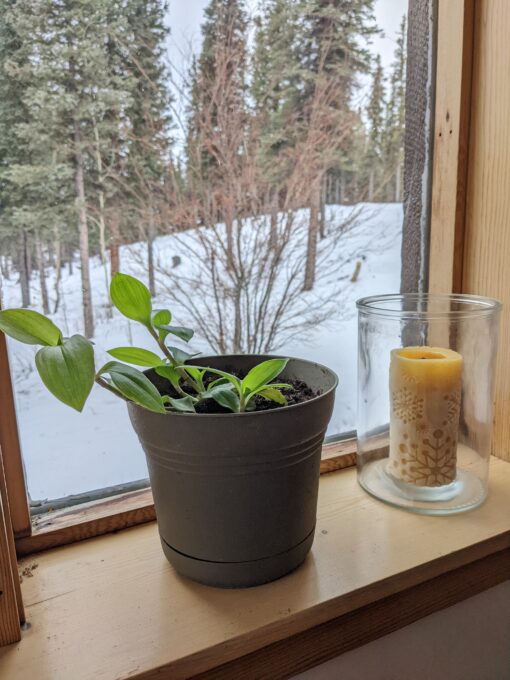“Inch by inch, row by row, gonna make this garden grow”… John Denver’s lyrics are often an earworm on my internal playlist, something I hum as I tend my “piece of fertile ground”.
I have always considered myself to be a gardener. My childhood home included a large patch of vegetables adjacent to our house and blackberry thickets bordering the yard. I was raised by thrifty parents who taught me the economic benefit of growing our own produce in rural New Hampshire. In Alaska, my own family homestead has always included a garden, where I’ve raised my children to appreciate the superior quality of a home-grown salad and to savor the crispness of a locally-grown carrot. But my attention and skills as a gardener have always been trained on outdoor plant production and consumable varieties.
In my experience, plants have belonged outdoors. Aside from a few pots of herbs that I keep indoors on windowsills in the extended growing season (purely so that they are more accessible to the kitchen when needed to season a recipe), green things are in the greenhouse. Horizontal space in our family home is limited and has been prioritized for other pursuits. Until now.
Emboldened by others, I am cautiously entering the world of houseplants. I’m making a soft entry, starting small and easy. Baby steps. My brother-in-law gave me a cutting this fall from the Plant Formerly Known As Wandering Jew, also known as the Inch Plant, or the more politically correct “wandering dude”. This commonplace greenery is a plant that goes by many names, and it is the subject of a grassroots movement to rename and remove offensive connotations. A spiderwort in the genus Tradescantia, inch plants purportedly get their name from their leaf structure, having leaf nodes that are about an inch apart on their stem.
When I first learned of its (most common) common name, I mistakenly assumed that it was due to the plant’s rapid growth, as my precocious cutting has been extending its reach by about an inch a week. In learning more about the inch plant, I discovered that this is a common misperception. However, consistent with its namesake, the plant does exhibit the characteristic of fast growth.

There are many creeping and trailing varieties of inch plants. My newly adopted resident has bright green and glossy smooth leaves, but variants include purple, pink, green or cream colored leaves with solid, striped or variegated patterns that may be fuzzy or smooth in texture. Tiny delicate flowers are infrequent on this houseplant, but may be white, pink, purple, or blue.
These plants are short-lived perennials and require propagation every few years. It’s easy to propagate, or repropagate the original plant, by cutting a healthy stem with three to five leaves, placing it in a jar of water for a week or so, and then planting it in soil to generate new growth in the same pot or establish a new container. That’s how my plant started, as a cutting in Chugiak, and after a few hours in the car relocating northward to our home, I plunked it in a pot, installed it in a south-facing window, and now it is thriving.
WIth a reputation as a sturdy, flexible plant, the inch plant’s demands aren’t too high for living condition requirements and care. The plant does best in bright, indirect light, and is comfortable at room temperature. The soil should be consistently moist, but in the winter the plant can tolerate drier soils. Our dry winter air in the interior of Alaska might lack the humidity of the inch plant’s native Mexican or South American climate, but I can easily arrange for my inch plant to take a vacation to the bathroom windowsill if the leaves start to dry out.

The windowsill is a temporary winter habitat for this new member of our household. With rapid growth, its trailing foliage is best suited to hanging high. I’m committed to keeping this test case – it has grown on me! So dedicated, in fact, that I am currently eyeing locations to permanently install a high shelf or hanging planter, so that my windowsills will be available for edible herbs next spring and my inch plant will be happier. When choosing a location, keep in mind that this plant is toxic to pets and may cause allergic reactions for furry pets.
So I offer this tale of encouragement to any other aspiring houseplant keepers. Just as a novice and hesitant pet owner might start with a goldfish before committing to the care and wellbeing of a golden retriever, if you are new to indoor gardening, you may wish to start with an inch plant. If you live in my neighborhood, I should be able to offer a cutting in a few weeks.
About Martha Tomeo
Twitter •